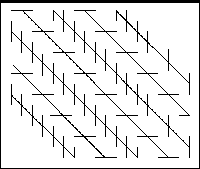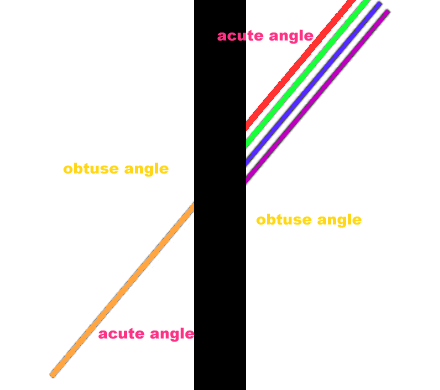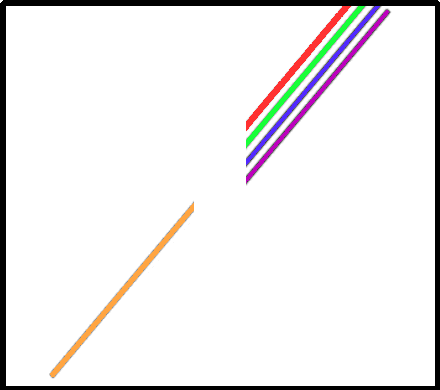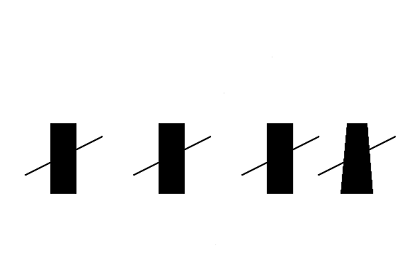History and Significance for understanding vision
 Poggendorf's
illusion was discovered in Johabb C. Poggendorf, an editor of a Physics
and Chemistry journal, in 1860. The illusion is based upon Zoellner's Illusion,
another illusion that causes the viewer to misinterpret the angles of lines.
In the illusion to the left, all the longer lines are parallel to each
other, however, they appear askew. When this illusion was described to
Poggendorf, he realized that people "have a very difficult time being
able to visually determine the differences in length between vertical and
horizontal lines at varying angles to one another. (1)"
Poggendorf's
illusion was discovered in Johabb C. Poggendorf, an editor of a Physics
and Chemistry journal, in 1860. The illusion is based upon Zoellner's Illusion,
another illusion that causes the viewer to misinterpret the angles of lines.
In the illusion to the left, all the longer lines are parallel to each
other, however, they appear askew. When this illusion was described to
Poggendorf, he realized that people "have a very difficult time being
able to visually determine the differences in length between vertical and
horizontal lines at varying angles to one another. (1)"
There are 2 main theories used to explain for
Poggendorf's Illusion: Angular Displacement, and
Depth
Processing Theory.
Angular Displacement Theory
 When
the bar covers the set of lines, it creates 2 acute angles and 2 obtuse
angles as labeled. It is theorized that our visual system may be over estimating
the degree of the acute angles and underestimating the degree of the obtuse
angles. This would cause the diagonal lines to appear to bend away from
each other and therefor not connect. (The orange line connects to the green
line in the image to the right.)
When
the bar covers the set of lines, it creates 2 acute angles and 2 obtuse
angles as labeled. It is theorized that our visual system may be over estimating
the degree of the acute angles and underestimating the degree of the obtuse
angles. This would cause the diagonal lines to appear to bend away from
each other and therefor not connect. (The orange line connects to the green
line in the image to the right.)
The visual system is capable of this angle
overestimation as proved by Hubel and Wiesel. They found that they could
explain angle overestimation in a similar manner that lateral inhibition
is explained. The visual system contains many different cells that respond
very well to orientations. There are different cells that respond to different
orientations. When presented with acute angles, some cells will respond
vigorously while others will remain at their normal firing rate and yet
others will fire at a below normal rate (inhibition). When the visual system
is presented with an obtuse angle, those cells that responded to the acute
angle will remain at their steady firing rate, while some of the cells
that did not previously respond, will fire more vigorously, and other cells
(those that are more attuned to other angles) will fire at a rate below
normal. 
Placing an obtuse angle next to an acute angle
can lead to lateral inhibition, where the various cells that are giving
responses interact with each other and cancel out each other's responses.
If one side's response and inhibition is stronger than the other, this
can lead to an angle appearing larger or smaller than it really is. (2)
However, angle displacement does not fully
explain Poggendorf's Illusion, for if it did, removing the angles should
diminish the effect of the illusion, and as you can see by the image on
the right, it does not.
 Depth
Processing Theory
Depth
Processing Theory
As you can see by the figure on the left,
the disjointed line effect is greatly diminished when the receding lines
are behind it. The receding lines add the illusion of depth and give the
viewer the impression that the image is a standing block with a line placed
at an angle behind it. The effect is even further diminished when the block
is placed in the same plane as the receding lines. However this last image
is not the same as Poggendorf's Illusion and so cannot be used to fully
explain the effect of the illusion. (3)
So what have we learned?
 Poggendorf's
illusion was discovered in Johabb C. Poggendorf, an editor of a Physics
and Chemistry journal, in 1860. The illusion is based upon Zoellner's Illusion,
another illusion that causes the viewer to misinterpret the angles of lines.
In the illusion to the left, all the longer lines are parallel to each
other, however, they appear askew. When this illusion was described to
Poggendorf, he realized that people "have a very difficult time being
able to visually determine the differences in length between vertical and
horizontal lines at varying angles to one another. (1)"
Poggendorf's
illusion was discovered in Johabb C. Poggendorf, an editor of a Physics
and Chemistry journal, in 1860. The illusion is based upon Zoellner's Illusion,
another illusion that causes the viewer to misinterpret the angles of lines.
In the illusion to the left, all the longer lines are parallel to each
other, however, they appear askew. When this illusion was described to
Poggendorf, he realized that people "have a very difficult time being
able to visually determine the differences in length between vertical and
horizontal lines at varying angles to one another. (1)"
 When
the bar covers the set of lines, it creates 2 acute angles and 2 obtuse
angles as labeled. It is theorized that our visual system may be over estimating
the degree of the acute angles and underestimating the degree of the obtuse
angles. This would cause the diagonal lines to appear to bend away from
each other and therefor not connect. (The orange line connects to the green
line in the image to the right.)
When
the bar covers the set of lines, it creates 2 acute angles and 2 obtuse
angles as labeled. It is theorized that our visual system may be over estimating
the degree of the acute angles and underestimating the degree of the obtuse
angles. This would cause the diagonal lines to appear to bend away from
each other and therefor not connect. (The orange line connects to the green
line in the image to the right.)

 Depth
Processing Theory
Depth
Processing Theory